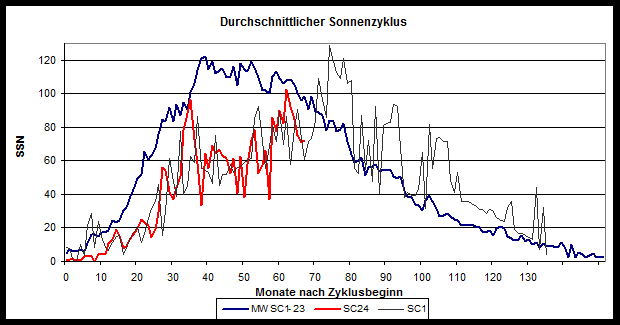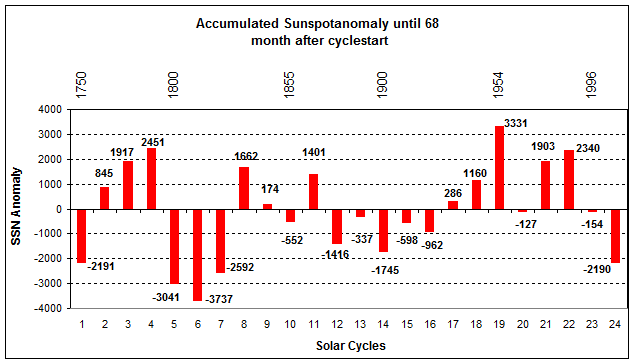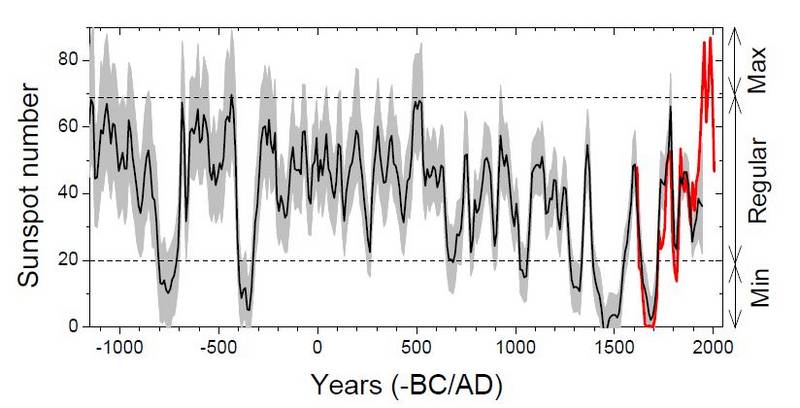The Sun In July 2014 And Arctic Sea In Mid Summer
By Frank Bosse and Fritz Vahrenholt
(Translated/edited by P Gosselin)
Last month the sun was variably active: The first ten days of the month were eventful, whereas the middle of the month solar activity was very calm with the negative high point occurring on July 17, when zero sunspots were recorded at a time during the maximum. At the end of the month activity picked up again with mean sunspot number for the month was 72.5. Once again the most activity took place in the southern hemisphere. The numbers: 47.1 as opposed to 25.4 for the northern hemisphere. This is 73% of the activity that is usual for this month into the cycle.

Figure 1: Monthly sunspot number for the current Cycle 24 (red), which began in December 2008. In comparison to the mean value of previous cycles 1 – 23 (blue) and the similar Cycle 1.
For a comparison of all cycles, the anomalies of each cycle (i.e. the difference between the monthly SSN data and the mean value) are plotted in the next chart:

Figure 2: Accumulated monthly deviation from the mean for the observed cycles since 1750.
The diminishment of solar activity in the current millennium can be clearly seen. Between 1945 and the mid 1990s we witnessed a profoundly long protracted period of activity. This unusual development is confirmed by a recently published paper by Finnish scientist Ilya Usoskinvon of the University of Oulu appearing in Astronomy and Astrophysics (A&A Volume 562, February 2014). The paper shows that the height of solar activity from 1945 to 1995 was a rare event over the last 3000 years. Pronounced minima such as the Maunder Minimums (from 1645 to 1715) on the other hand are much more frequent.

Figure 3: Sunspot number reconstructed by Usoskin et al. (2014), from 1150 BC until 1950 AD. The red curve depicts the directly observed sunspot count since 1610.
A Chinese paper by the Center for Space Science and Applied Research der Chinese Academy of Sciences in Peking (ZHAO X H, FENG X S., Chin Sci Bull, Chin Ver., 2014, 59: 1284: “Periodicities of solar activity and the surface temperature variation of the Earth and their correlations”) goes a step further in its conclusion:
“During the past 100 years, solar activities display a clear increasing tendency that corresponds to the global warming of the Earth (including land and ocean) very well. Particularly, the ocean temperature has a slightly higher correlation to solar activity than the land temperature. All these demonstrate that solar activity has a non-negligible forcing on the temperature change of the Earth on the time scale of centuries.”
=============================
I will present Vahrenholt’s and Bosse’s second part on Arctic sea ice tomorrow! -PG





Similar to this 11000yr reconstruction (last 2000yrs)
http://en.wikipedia.org/wiki/File:Sunspots_11000_years.svg